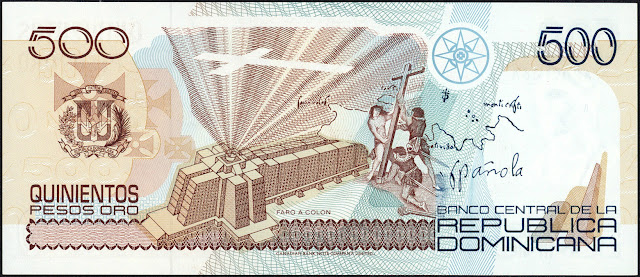Currency of the Dominican Republic 500 Pesos Oro banknote 1992
The Quincentennial of First Landfall by Christopher Columbus in the New World 1492-1992
Central Bank of the Dominican Republic - Banco Central de la República Dominicana
Obverse: Portrait of Christopher Columbus at right (This is an undated portrait of Italian explorer Christopher Columbus attributed to Rodolfo Ghirlandaia. The original is in the Naval Museum of Pegli in Genoa, Italy, Columbus’ birthplace). Seal of the Central Bank of the Republic and old navigation astrolabe at right. Old painting of the three ships used by Christopher Columbus in his first voyage: La Niña, La Pinta, and Santa Maria & Coat of Arms granted to Christopher Columbus and the House of Colon by Pope Alexander VI in 1502.
Signatures: Luíz Toral Córdoba (Gobernador del Banco Central) and Licelot Marte de Barrios (Secretario de Estado de Finanzas).
Reverse: Coat of arms of the Dominican Republic at left. Columbus Lighthouse (Faro a Colón); placement of Cross of Christianity; Part of a hand-drawn map by Christopher Columbus shows the northern coast of Española (Hispaniola), where his flagship the Santa Maria sank in 1492.
Printer: Canadian Banknote Company.
Dominican Republic Banknotes - Dominican Republic Paper Money
1977-1998
500 Pesos Oro banknote 1992 Commemorative issue of Quincentennial of First Landfall by Christopher Columbus in the New World 1492-1992
Columbus Lighthouse
Columbus Lighthouse (Spanish: Faro a Colón) is a monument located in Santo Domingo Este, Dominican Republic, in tribute to Christopher Columbus.
Construction began in 1986 using plans drawn by Scottish architect J.L. Gleave in 1931, in time for the 500th anniversary of the Discovery of America, the monument was inaugurated in 1992. It was funded by the Latin American states and the total cost of construction was approximately US$70 million.
The monument's lighthouse-style features projecting beams of light, forming a cross shape, which are so powerful they can be seen from neighboring Puerto Rico.
Containing what are purported to be the remains of Columbus, the monument is both a mausoleum and a museum showcasing objects including a boat from Cuba and Columbian jewelry. Constructed of concrete, the monument is 680 feet (210 m) long. Its architecture is cross-shaped and represents the Christianization of America.
500 Pesos Oro banknote 1992 Commemorative issue of Quincentennial of First Landfall by Christopher Columbus in the New World 1492-1992
Christopher Columbus (1451-1506) a Genovese sailor and explorer, died after four voyages to the New World, he was convinced that he had discovered a sea route to Asia. The son of an Italian weaver; he found the harbor and wharves of his native city of Genoa much more interesting than his father’s looms. He had at least two brothers. Christopher had little education and, only as an adult, learned to read and write. However, as a young man, Christopher went to Portugal and got involved in the map-making business with his brother, Bartholomew. This business made Columbus a rich man. His books of maps are still found today in every library in the world.
Columbus’s desire to sail westward was fueled in part by maps and writings of a Florentine humanist Paolo Toscanelli. When Columbus sailed in 1492, in three ships (la Niña, la Pinta y la Santa Maria) financed by the Spanish Kingdom, he finally reached land in the West on October 12 of that year. In the course of his own further voyages he explored much of what we know today as the Caribbean and parts of Central and South America.
Columbus landed on the island of Hispaniola (the second-largest island in the West Indies) in 1492. He was favorably impressed by the friendliness of the Taínos who greeted him; he was even more impressed by the gold they wore. In 1496, Columbus’s brother, Bartholomew, founded the port city of Santo Domingo - the oldest city in the Western Hemisphere- on Hispaniola. Santo Domingo was called originally Santiago de Guzmán located on the island’s southern coast. This city became the administrative capital for all of Spain’s colonies in the Americas.
In 1992, during the celebration for the 500th Anniversary of Columbus’s arrival in the Americas, the most significant part of the celebration was the Faro a Colón, or Columbus Lighthouse, the construction of which was first discussed in the mid-1800s. The design for the Columbus Lighthouse was chosen through an architectural international contest won by J.L. Gleave in 1931, but construction was not started until 1986.
Banco Central de la Republica Dominicana issued a commemorative note of 500th anniversary of Columbus voyage (1992). Columbus’ portrait appears at right and also as watermark with sailings ships at center. Also, the seal of the Central Bank is at right. The ‘Faro a Colón’ (Columbus’ Lighthouse), placement of Cross of Christianity and Hispaniola map outline are at center; the coat of arms is at left on back.
The denomination is 500 Pesos Oro. Also, the Central Bank of Dominican Republican issued a specimen collection, all the banknotes with zero serial numbers and stamped “MUESTRA.” The design of this multicolored note was made in Dominican Republic but printed in Canada by CBNC. Dimensions are 156 x 67 mm.

